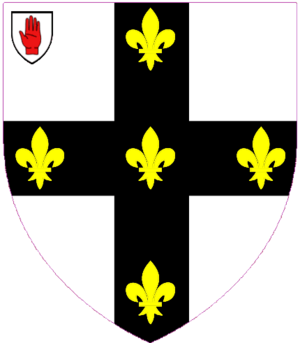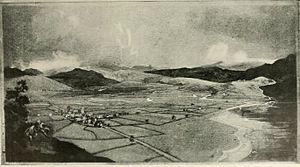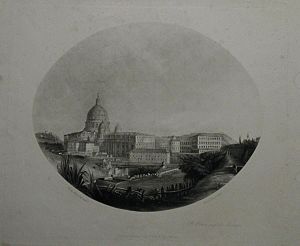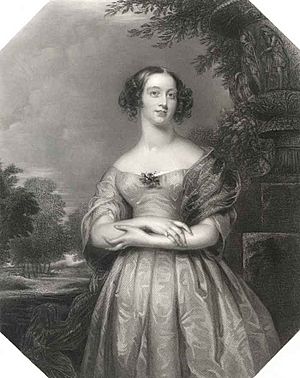Sir Digby Neave, 3rd Baronet facts for kids
Sir Richard Digby Neave (1793–1868), often known as Digby Neave, was an English artist and writer. He held the title of a baronet, which is a special honor passed down through families.
Contents
Early Life and Education
Digby Neave was the oldest son of Sir Thomas Neave, who was the 2nd Baronet. He also had a brother named Sheffield Neave. Digby went to St Mary's Hall, Oxford University and finished his studies in 1815. Later, he mentioned that Edward Penrhyn traveled with him in 1817 and 1818. In 1821, Neave took on a role as the Steward of the Liberty of Havering-atte-Bower.
Working with Railways
Digby Neave had family connections to Abel Rous Dottin. Because of this, he went to the very first meeting for the London and Greenwich Railway in October 1831. This meeting happened at Dottin's house in London. Neave became one of the directors for this railway company. He worked there until he resigned in November 1836. After that, in 1837, he also got involved with the Dover Railway Company and the New Gravesend Railway Company.
Helping the Poor
In January 1836, Digby Neave became one of the first Assistant Poor Law Commissioners. This job involved helping to manage support for poor people in the Chester area. At that time, he was known as a Justice of the Peace from Havering atte Bower in Essex. He got this important job because "E. Penhryn" recommended him to John Shaw-Lefevre. This person might have been Edward Douglas-Pennant, 1st Baron Penrhyn, or perhaps his friend Edward Penhryn, who was a lawyer. Another person who recommended him was his cousin, Sir Charles Trevelyan.
Neave worked with Edward Gulson, who was like a mentor to him. They met with Henry Pelham-Clinton, 4th Duke of Newcastle at Clumber Park in February 1836. Neave also met with Robert Lowe in Bingham, Nottinghamshire to discuss issues with the Poor Law system in Nottinghamshire.
Edwin Chadwick was looking for information to argue against the Cheshire Constabulary, a police force set up in 1829. Neave provided him with this information. During the 1837 United Kingdom general election, some people in Cheshire resisted the changes to the poor law. Neave called this "backsliding." Even with his efforts, the Chester workhouse did not fully change according to the Poor Law Amendment Act 1834. It continued to operate in the old way until the 1860s.
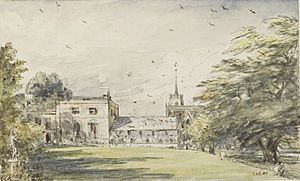
Friendship with John Constable
Digby Neave was a good friend of the famous painter John Constable. He visited Constable's art studio in London in May 1819. In 1825, Constable painted portraits of both Neave and his brother Sheffield. That same year, Neave became the godfather to Constable's daughter, Emily. Constable even stayed with Neave at Pitt Place in Epsom. At that time, in 1831, Neave was renting Pitt Place from Rowland Stephenson. Neave and his family later bought the house at an auction in 1840.
Later Life
By 1841, a book described Pitt Place as Neave's main home. He became the third baronet after his father passed away in 1848. Later, he lived at Dagnam Park in Romford, Essex. In 1861, he was chosen to be a member of the Royal Geographical Society.
His Works
Digby Neave was a landscape painter. He showed one of his paintings, called A Scene in the New Forest, at the Royal Academy. Two of his landscape paintings were made into prints by David Lucas.
Neave also wrote a travel book called Four Days in Connemara (1852). This book was written after the Irish Famine. The magazine The Athenaeum said it was "more about arguments than places." The book looked at workhouses and places where people were sent for correction. Four Days also showed concern about the Irish elections happening in Autumn 1852. These elections led to many Irish Members of Parliament working together to change land ownership rules in Ireland.
Family Life
Digby Neave married Mary Arundell. She was the daughter of James Everard Arundell, 9th Baron Arundell of Wardour. They had six sons and five daughters:
- Arundell Neave, 4th Baronet: He married Gwyn Gertrude Hughes. Their son, Thomas Lewis Hughes Neave, 5th Baronet, became a major landowner. He owned nearly 10,000 acres of land in England and Wales.
- Edward Digby (1830–1858): He worked in the Bombay Civil Service.
- Kenelm (died 1861): He was part of the Bombay Army.
- Wyndham (died 1858): He was in the 71st Highlanders and died in battle in Morar, Gwalior in June 1858.
- Ednowain Reginald: He graduated from Trinity Hall, Cambridge in 1865.
- Augustus: He died as a baby.
And their daughters:
- Mary Blanche: She married John Richard Westgarth Hale in 1860.
- Frances Eleanor
- Venetia: She married the cleric and landowner John Whitaker Maitland in 1860.
- Cicely: She married the lawyer Wyndham Slade in 1863.
- Mariquita: She married Alexander George Middleton, her second cousin, in 1874.
|


